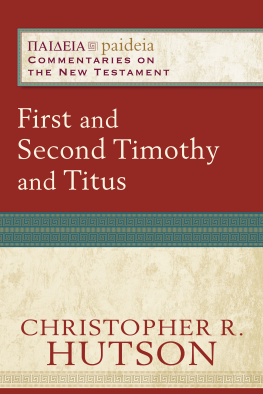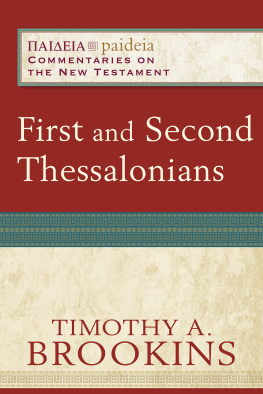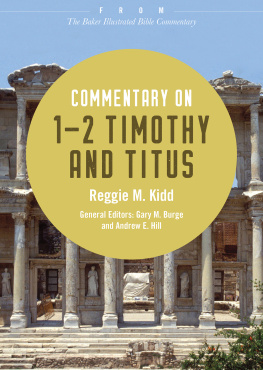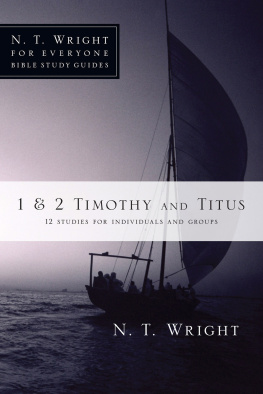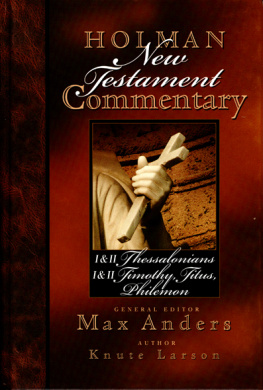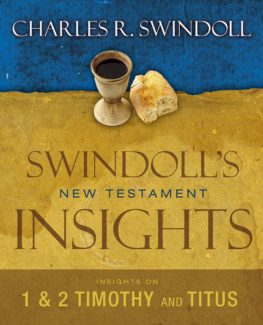1. Terra-Cotta Image of Aeneas
2. Flaunting Wealth: Mummy Portrait of a Woman
3. Flaunting Virtue: Sculpture of Livia Drusilla
4. Mount Juktas in Crete
Foreword

Paideia: Commentaries on the New Testament is a series that sets out to comment on the final form of the New Testament text in a way that pays due attention both to the cultural, literary, and theological settings in which the text took form and to the interests of the contemporary readers to whom the commentaries are addressed. This series is aimed squarely at studentsincluding MA students in religious and theological studies programs, seminarians, and upper-division undergraduateswho have theological interests in the biblical text. Thus, the didactic aim of the series is to enable students to understand each book of the New Testament as a literary whole rooted in a particular ancient setting and related to its context within the New Testament.
The name Paideia (Greek for education) reflects (1) the instructional aim of the seriesgiving contemporary students a basic grounding in academic New Testament studies by guiding their engagement with New Testament texts; (2) the fact that the New Testament texts as literary unities are shaped by the educational categories and ideas (rhetorical, narratological, etc.) of their ancient writers and readers; and (3) the pedagogical aims of the texts themselvestheir central aim being not simply to impart information but to form the theological convictions and moral habits of their readers.
Each commentary deals with the text in terms of larger rhetorical units; these are not verse-by-verse commentaries. This series thus stands within the stream of recent commentaries that attend to the final form of the text. Such reader-centered literary approaches are inherently more accessible to liberal arts students without extensive linguistic and historical-critical preparation than older exegetical approaches, but within the reader-centered world the sanest practitioners have paid careful attention to the extratext of the original readers, including not only these readers knowledge of the geography, history, and other contextual elements reflected in the text but also their ability to respond correctly to the literary and rhetorical conventions used in the text. Paideia commentaries pay deliberate attention to this extratextual repertoire in order to highlight the ways in which the text is designed to persuade and move its readers. Each rhetorical unit is explored from three angles: (1) introductory matters; (2) tracing the train of thought or narrative or rhetorical flow of the argument; and (3) theological issues raised by the text that are of interest to the contemporary Christian. Thus, the primary focus remains on the text and not its historical context or its interpretation in the secondary literature.
Our authors represent a variety of confessional points of view: Protestant, Catholic, and Orthodox. What they share, beyond being New Testament scholars of national and international repute, is a commitment to reading the biblical text as theological documents within their ancient contexts. Working within the broad parameters described here, each author brings his or her own considerable exegetical talents and deep theological commitments to the task of laying bare the interpretation of Scripture for the faith and practice of Gods people everywhere.
Mikeal C. Parsons
Charles H. Talbert
Bruce W. Longenecker
Preface

I grew up in a family that was at church every time the doors were open, which was at least three times per week. I grew up knowing that our church was organized just like the Bible said. Our congregation had elders and deacons who were married men with faithful children, just as we read in 1 Tim. 3 (with a glance at Titus 1). Women never spoke in the worship assembly, just as we read in 1 Tim. 2. When I was a teenager, our minister organized a Timothy Class to teach boys how to lead worship, and when we did, I was the preacher. My dad was a deacon. My mom taught Sunday school. And I was one of four faithful children. That was all I knew about the Letters to Timothy and Titus, and all I needed to know, or so I thought.

